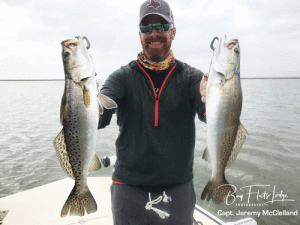
“Cold Water Trout”
Happy New Year my fellow anglers! 2019 is here and with the flip of the calendar to January I find myself remembering the first half of this month has given way to some of my best days on the water. I love this time period for many reasons but the most notable is the fact that there are few boats on the water, fewer still anglers to contend with and a seemingly endless supply of hungry Speckled Trout to play with.
Wading with lures is the way to go for my favorite days this first half of January making sure I have the right tackle along with me before slipping into the water. I like to focus on bait movement first and foremost. Next I am looking for the multitude of cuts and guts in the bay floor because they attract the trout who use them as ambush points. Add to that areas of water that are a bit stained and then water that looks like a boat just peeled out churning up the muddy bottom. These spots are even better if they are in a waist deep soft mud flat.
The arsenal of lures I carry is a simple one but covers all the presentations I will likely lean on. My wade belt will have a plastic box containing various colors of darks and lights of offerings such as: slow sinking soft baits like the Corky (Brown) Original Suspending Twitchbait and also the Corky Devil; flapping tail type plastic lures that move up and down and swim straight like the Texas Tackle Factory (TTF) Redfish Killer, Killer Flats Minnow and Killer Hustler; larger soft plastics that float a bit more and look huge in the water like the Down South Southern Shad; darting plastics that are smaller, more slim and with more speed and movement like the TTF Trout Killer; and finally just for kicks an assortment of topwater baits like the Heddon Super Spook, SSJr and One Knocker. Throw in a couple screw lock jig heads, my choice the TTF 1/16 oz for the shallows and 1/4 oz for the drop offs and the wade is on. This assortment in type and color is way too much for any one anger and definitely for any given wade, but it’s because of this variety that I have confidence in dedicating myself to a body of water and working all aspects of it that have worked in the past of that I can think of to fool a fish.
Keying in on bait movement is at the top of my agenda right now because when you find the bait, and I’m talking mullet mainly, you will realize the trout are nearby. The water temperatures are ranging from the high forties around cold fronts to the middle sixties between them and the bait and the predators are reacting to these swings quicker than you might imagine. When I see bait present I try to determine which ‘type’ of bait presence is going on. Is it one mullet jumping up in the shallow water or is it a wad of finger mullet cruising in a couple of feet? I am hoping for the latter and once I can tell what’s going on I quickly try to calculate which of my lures is appropriate for the conditions. Being patient with my lure choice and giving it a good twenty or more casts before changing, I move slowly through my target area to be sure I cover it entirely. I have fished with many professional anglers and what I have noticed is they move slower through the water and they cover a flat in a semi circle fashion stopping to cast far to the right then through the middle then far to the left, working the entire water column before taking another step. This is crucial when you are fishing waters that are colder because the fish are not moving as fast as in the warmer months. The fish may be there right in front of you but if you trudge forward with an undisciplined spread of casts you may take the bait right out of their mouths. Slow down and think more action on your lure and less speed.
Once I determine a good piece of water to focus on where the bait is working, I am looking for the multitude of cuts and guts in the bay floor because they attract the trout who use them as ambush points and you may also notice these areas of water that are a bit stained and the water looks churned up on the muddy bottom. Most of the time this is an afterthought because if I have found the bait I am near certain I’m in the land of the bottom change and out of the gin clear water. Moving around to find these peaks and valleys is easy once you are in the water though and this is another reason to take it slow. Parking the boat away from bait activity fifty or so yards is important to mention here. That way you get some room to mess up the water and keep the noise away from the real estate you plan to rummage through. Get all that stuff out of the way and get ahold of yourself before sneaking up to your prey. This gives you time to get the pre-game jitters out and make a few casts to be sure your reel and line are in good shape before you stick that first fish. Nothing worse than feeling the thump of a trout and bird
nesting a reel to kill your enthusiasm.
Capt Stephen Boriskie, Bay Flats Lodge
Seadrift, Texas, 888-677-4868
